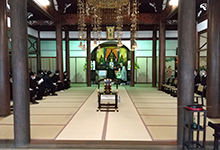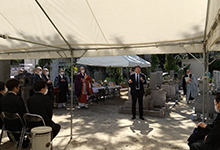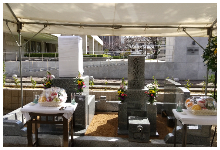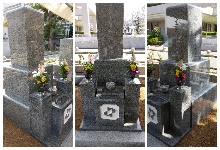Today's Notables
Corporate Grave Construction and First Anniversary for Minoru Furuichi’s death
May 2021
Hisashi Furuichi
Chairman of the Board
On March 6th, we held a memorial service for my father, Minoru Furuichi, at the Kaiseiji Temple monastery, which is part of Rinzai Myoshinji Temple sect, in Nishinomiya city. I had hoped to invite more people but with the Corona virus, we decided to keep it to a minimum of family members, executives officers of Primix, and members of the company friendship association. I would like to take this opportunity to express our deepest gratitude to everyone who attended.
 |
 |
I am deeply moved that often, when people hear my last name and learn that I am Minoru Furuichi’s son, they comment about how my father had a positive impact in their lives and what he did to help them during his lifetime. It is a testimony to my father’s gregariousness and friendliness. He was loved by many. My grandfather, Shuji Furuichi’s, remains were also moved from the grave in Saitama and buried in the same grave alongside by father and brother. Now the Furuichi ancestors are together. At the same time, along with the grave of the Furuichi family, we constructed the corporate grave, which I had long wanted.
After visiting a company about 6 or 7 years ago, I noticed in the company museum, there was a photo of the corporate grave along with an explanation. Since then, I have been interested in that idea, and thus looked into what companies have set up cemeteries and how they did it. Then, I found that there are more than 100 corporate graves in Koyasan Kongobuji Okunoin alone. There are many other places such as Hieizan Enryakuji that also have graves. "On record, Matsushita Electric Industrial Co., Ltd. (at that time) was the oldest corporation in 1938." (from an article in the Nihon Keizai Shimbun). Many of the tombstones were also unique, including UCC coffee cup-shaped tombstones and Yakult tombstones in the shape of Yakult containers. But why, I thought. Togo Yoshikawa (57) of Kongobuji in Koyasan, who manages the graveyard of Okunoin, told me that some people call them corporate graves, but these are memorial monuments built by the company. They are offering them as a memorial for the deceased employees. Some of graves are built by industry groups, and during the Edo period, Hatago and shops built stone monuments. (From an article in the Nihon Keizai Shimbun). Therefore, when I consulted with Master Masamichi Genshitsu of Kaiseiji Temple, I immediately went to see Kyocera's corporate grave at Empukuji Temple in Kyoto, which also serves as a temple. In addition, there is a memorial monument of Hanshin Electric Railway and a corporate grave of Juchheim at Kaiseiji Temple. Mr. Masamichi suggested that building a corporate grave was a meaningful, generous gesture.
The Furuichi family was able to prosper because my grandfather started this business which was taken over by my father and brother. More than that, it is all the people who worked so hard for the company that we owe a debt of gratitude. Some died during their tenure at the company and many spent most of their lives working at PRIMIX. Furthermore, some people do not have children to take over their house or only the eldest son can enter the grave because of certain family customs. Some people say that they don’t need or want a grave, but for those left behind, that is not always the case. It would be sad to think that there is no sacred place to join hands to thank or memorialize ancestors or a particular individual. So with that, we built a corporate grave to serve as a permanent memorial for those who wish to give gratitude to those who have gone before us.
We would like to express our sincere gratitude to the company for their understanding and cooperation in building the corporate grave. As for me, as long as I am well, I will continue to support and take care of the PRIMIX family.
 |
 |
HOME > What’s New > Today's Notables > Details














